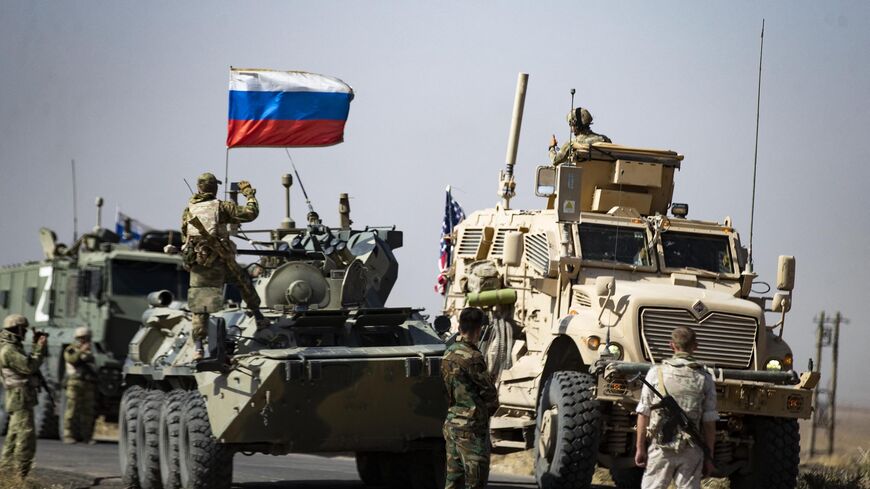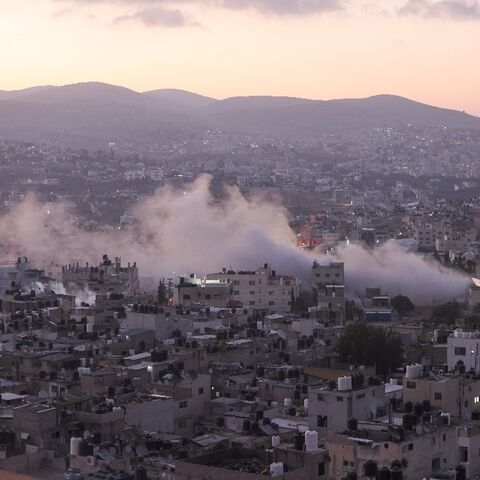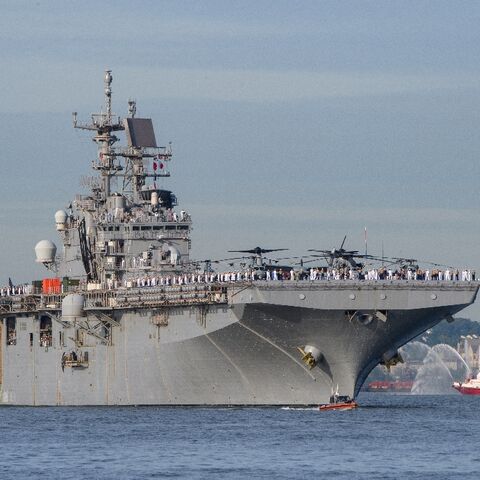WASHINGTON — Russian combat pilots have dialed back a recent wave of threatening armed flights over US bases in Syria since the Pentagon deployed stealth F-22 fighter jets to the region in order to ward them off last month, a senior US military official said Friday.
Attacks by Iran-backed militias on US bases in Iraq and Syria have also fallen silent since the Biden administration authorized airstrikes in March that killed an estimated 11 militia members in response to a drone attack just hours earlier that killed a US contractor at the Rmeilan air base near Hasakah.
Nonetheless, a senior US military official said Friday he has seen signs that Russian military commanders in Syria have been quietly coordinating with Iran’s Islamic Revolutionary Guard Corps (IRGC) on long-term plans to pressure the United States to withdraw its forces from the country.
“There's a confluence of interests between those three groups — the Iranians, Russians and Syrians,” the official explained.
“I see evidence of operational-level planning between mid-level Quds Force leadership that's operating in Syria [and] Russian forces that are operating in Syria,” said the official, who spoke on condition of anonymity to discuss sensitive intelligence.
The official declined to discuss the nature of the evidence, but when pressed by Al-Monitor, described the cooperation as “collaborative planning, collaborative understanding and intelligence sharing” at the “mid-level to upper echelon” of the respective Russian and Iranian militaries in Syria.
“Frankly, [it's] the same sorts of things that we would do with our partners in the face of something we were trying to accomplish,” the official said. “We see them doing that on their side, as they try to think about how they sync the different things that different arms of them are doing in order to put that pressure on us.”
The official noted an incident last week in which Russian Su-35 pilots harassed three US MQ-9 drones as they were preparing to conduct a strike on a senior Islamic State (IS) leader in Syria's northwest — though the official did not clarify whether that move was coordinated in any way with Iran's forces.
Why it matters: Pentagon officials deny their forces' actions in Syria have had anything to do with Russian and Iranian provocations, and say they believe recent US responses have arrested the escalation cycle for now.
"We don't anticipate an issue, nor do we see a level of escalation we're concerned about in Syria," the Joint Staff's top operations director, US Army Lt. Gen. Douglas Sims, told reporters earlier this week.
Still, the remaining contingent of roughly 900 American troops in Syria remains vulnerable nearly four years after former President Donald Trump's aborted withdrawal from the country ceded significant ground east of the Euphrates River to Russian and Syrian forces.
Previously, the river served as a mutually recognized boundary between the rival armies.
The aforementioned senior US military official on Friday argued that it would be imprudent to cede any more territory or airspace to Russian and Iranian forces in Syria. "Because as soon as you do, they'll just move to the next place and continue trying to pressure you," the offical said.
Al-Monitor first reported in February concerns among senior American military officials over the potential for Russian and Iranian cooperation against the small US troop presence in Syria as an outgrowth of Tehran’s military support for the Kremlin’s war in Ukraine.
Last month, The Washington Post reported that high-ranking Russian and Iranian military and intelligence officials had met last November and agreed to form a joint coordination center to align their efforts to put pressure US forces in Syria. The Post's story cited a leaked Pentagon document containing classified intelligence dating to late January.
The United States maintains its troops in Syria in the wake of the multinational campaign against IS under authorities originally granted by Congress in 2001 to enable the George W. Bush administration to pursue the planners of the Sept. 11 attacks. The Obama administration, which introduced US special operations forces into Syria in 2015, interpreted the 2001 Authorization of the Use of Military Force (AUMF) as legally sanctioning combat operations against IS, an offshoot of al-Qaeda.
Today, US troops are concentrated in the country’s far northeast and at a remote special operations outpost known as al-Tanf, which lies adjacent to a coveted border crossing on Syria's border with Iraq and Jordan.
The US presence in the northeast ensures an alliance of local militias known as the Syrian Democratic Forces (SDF) can continue to keep guard over more than 10,000 captured IS fighters and more than 50,000 of their suspected family members held at various camps and makeshift prisons. The Biden administration has sought to persuade foreign countries to repatriate their citizens from the camps with limited success, though little prospect remains of rehabilitation or international war crimes tribunals on the horizon for those who remain.
Russia’s military and the IRGC’s Quds Force both support the regime of dictator Bashar al-Assad in Syria’s stalemated civil war, but competition between the two over influence in key territory and access to bases has long inhibited high-level coordination against their mutual rival, the United States.
Following Russia's invasion of Ukraine last year, however, Russian combat pilots began increasingly violating airspace protocols agreed upon with American commanders in Syria by flying low over US bases there, particularly al-Tanf garrison. The armed overflights reached a new crescendo of roughly one per day this past March, the top commander of US forces in the Middle East, Gen. Michael “Erik” Kurilla, alerted congressional lawmakers in public testimony later that month.
“There was nothing different about our behavior at all from what we've been doing for five years, really, since the fall of … IS’ physical caliphate,” the senior US military official said Friday.
The United States and the SDF captured IS' final territory in March 2019 in Syria's far east. In October of that year, a helicopter-borne US Special Forces raid into a Turkish-controlled corner of northwestern Syria led to the death of IS' then-top leader, Abu Bakr al-Baghdadi.
A telephone line set up in 2016 to reduce the chances of conflagration between the US and Russian sides remains active, the official explained on Friday. “We have not had times where they’ve refused to answer the phone,” the official revealed. “That deconfliction line remains open. It sometimes gets very heated.”
Still, top US brass assess that neither Russian nor Iranian commanders in Syria want to get into a major firefight with their American adversaries anytime soon.
Keep them guessing. Russia’s forces may, however, try to knock down an American drone, the official said.
Unmanned US MQ-9s regularly spy on suspected IS- and al-Qaeda-linked operatives in Syria’s rebel-controlled northwest despite Russia’s refusals to grant airspace permission for such operations.
In March, a Russian Su-27 collided with a US MQ-9 drone over the Black Sea off the coast of the Crimean Peninsula, in an incident top Pentagon Gen, Mark Milley later characterized as part of a pattern of deliberate aggressive action by the Kremlin's pilots. Russia's Defense Ministry denied the collision occurred and later awarded the pilots involved commendation medals.
“The [Russian] generals in charge in Syria are often generals who were sent from Ukraine after they failed in one of the pushes to Kyiv, or in the Donbass,” the senior US official said Friday.
When reassigned to senior command roles in Syria, the US official said, “They’ve got something to prove.”
Early on Friday, a Russian aircraft moved to intercept a US MQ-9 over Syria, coming within three nautical miles in an encounter the official described as “unprofessional” but “not reckless” like last week’s encounters.
Russia’s military publicly announced last week it had kicked off counter-drone and air defense exercises over the country, but the US official cast doubt on that. “There's been no exercise that we can detect,” the official said.
Also on Friday morning, further south in Syria, a manned Russian Antonov An-30 aircraft flew over al-Tanf garrison “for an extended period of time," ostensibly to gather intelligence during a gap in US air patrols, the official said.
US officials called the Russians to raise their objections to the overflight, which the official said is part of a wider pattern of regular Russian surveilance not just over al-Tanf, but over the entire 55-kilometer (88-mile) buffer zone surrounding the site.
“I have to assume that they're collecting in our position, trying to, you know, see what our bases look like how our defenses are arrayed,” the official said.
The official told Al-Monitor that he assesses Russian and Iranian forces are sharing intelligence on US bases in Syria, but said he has seen no evidence that Russian surveillance played a role in either the March drone strike in Hasakah nor the prior drone attack on al-Tanf garrison in January.
What’s next: Once active conflicts with Iran-backed groups across the Middle East have largely fallen quiet for now, but national security officials say the danger of escalation in the region remains high.
Iran continues to flow weapons to militias in Syria and to the Houthis in Yemen, US officials say, despite reports of closed-door talks between US and Iranian officials as the Biden administration seeks further de-escalation in the region.
In Syria, there is "no imminent threat right now, but the weaponry is still flowing and the rockets are still flowing" to Iran-backed groups, the senior US military official said Friday.
Al-Monitor previously reported concerns among Pentagon officials that the flow of Russian funds to Iran as a result of their emerging military cooperation in Ukraine could help the IRGC expand its activities in the Middle East.
“We're not seeking to drive escalation,” the military official emphasized on Friday.
“These incidents where your forces are coming into contact with each other in close proximity, everyone's armed to the teeth, whether you're in the air on the ground. One false move, and it can it can turn ugly, pretty quick.”
Know more: The American ground presence in Syria may be smaller than those of the Russians and Iran-backed contingents, but the US Air Force is usually in dominant control of the skies.
The Pentagon deployed top-of-the-line F-22 fighter jets to Jordan from Europe last month in a bid to shake off Russian pilots who have repeatedly tried to goad American pilots into dogfights over Syria in recent months, the top Air Force commander in the region, Lt. Gen. Alex Grynkewich, said previously.
“The F-22s certainly had an impact on Russian behavior,” the aforementioned US military official said Friday. “We were able to maneuver behind them and maintain a position of advantage, [and] they stopped being quite as provocative.”
The official declined to discuss any new potential US deployments to the region, saying only that the stealth avionics of the F-35 Joint Strike Fighter would be “useful” for “defensive countermeasures.”
US F-16 will begin flying patrols over the Persian Gulf this weekend following a spate of recent seizure of commercial tankers by Iran.








